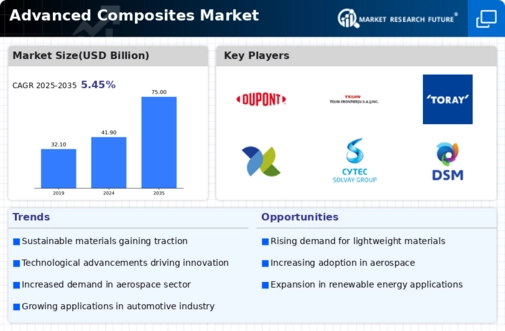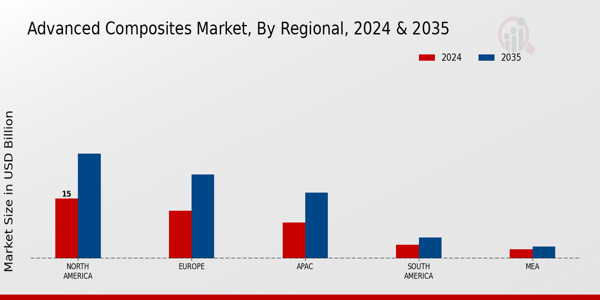Market Analysis
Advanced Composites Market (Global, 2024)
Introduction
The advanced composites market is set to undergo a significant transformation as the need for lightweight, high-strength materials that improve performance and efficiency continues to grow. The advanced composites market comprises a wide range of materials, including carbon, glass and aramid fibre composites. It is driven by the growing demand from a range of end-use industries, such as aerospace, automobiles, construction and renewable energy. The unique properties of advanced composites, such as their resistance to corrosion, their high strength and their design flexibility, make them the ideal material for applications that require superior performance under challenging conditions. Moreover, as the advanced composites market grows, the industry is set to focus on the development of new manufacturing techniques and the use of sustainable processes. This dynamic industry presents both challenges and opportunities for the companies operating in it, such as the need to comply with regulations and to find cost-effective solutions in an increasingly competitive environment.
PESTLE Analysis
- Political
- In 2024, government policy increasingly favors the use of high-tech composites, especially in the military and aeronautical sectors. For example, the U.S. Department of Defense allocates some $ 1.2 billion for the development of new materials, including composites, to enhance military capabilities. The European Union, moreover, adopts regulations promoting sustainable materials, and sets a goal that by 2025, at least 30% of all public procurements should be in advanced composites.
- Economic
- In 2024, the global economy is characterized by a projected increase in manufacturing. The International Monetary Fund estimates a 3.5% growth rate in the manufacturing sector. This growth will mainly affect the demand for advanced composites in the automotive and aeronautical industries, where the combined spending on lightweight materials is expected to reach 15 billion dollars. In addition, the rising cost of traditional materials, steel for example, which will average 800 dollars a ton, will push manufacturers to look for cheaper composite alternatives.
- Social
- A survey conducted in the developed countries shows that 68 per cent of consumers are willing to pay a premium for products made from advanced composites. This trend is especially visible in the automobile industry, where manufacturers are increasingly turning to composites to reduce the weight of their vehicles and thus improve fuel efficiency. And with growing awareness of the environment, more and more companies are investing in advanced composites. By 2024, the investment in sustainable composites is expected to reach $500 million.
- Technological
- The production of advanced composites is advancing rapidly. The introduction of automation has made it possible to produce large quantities. By 2024 it is expected that 40 per cent of the production of advanced composites will be automated, reducing production time and costs. Also, 3D printing of composites is gaining in importance, and by 2024 the market for 3D printed composites is expected to reach $1.5 billion. These developments in technology will broaden the field of applications for advanced composites.
- Legal
- In 2024 the regulatory framework for the use of advanced composites is becoming more and more strict, especially in the field of aeronautics and automobiles. In the United States, the Federal Aviation Administration has issued new guidelines that by 2024, in order to ensure the safety and performance of new aircraft, the composite content of all new parts should be increased from 25% to 50%. It is becoming mandatory for manufacturers to comply with international standards such as ISO 9001, and in this sense about 60% of advanced composites companies are seeking certification to meet the legal requirements.
- Environmental
- In the field of environment, the study of the recyclability and life cycle assessment of advanced composites is carried out. It is estimated that by 2024 about twenty per cent of the advanced composites produced will be made from recycled materials, thereby demonstrating a growing concern for the environment. In addition, the carbon footprint of composite production is being addressed by measures to reduce emissions by fifteen per cent by 2025. The industry is investing in the development of eco-friendly production methods, and it is estimated that in the coming year about $300 million will be spent on research into biodegradable composites.
Porter's Five Forces
- Threat of New Entrants
- In 2024, the threat of new entrants to the Advanced Composites Market is moderate. There are high barriers to entry, including high capital requirements, and a need for specialized technology and expertise. Also, economies of scale and strong brand recognition, which the established companies benefit from, can act as a deterrent to newcomers. However, technological developments can lower some of these barriers, thereby making it easier for niche players to enter the market.
- Bargaining Power of Suppliers
- The bargaining power of suppliers in the market for advanced composites is medium. It is based on a limited number of suppliers of raw materials such as carbon fibres and resins, which gives the suppliers some leverage. However, the growing number of alternative materials and the potential for vertical integration in the supply chain may reduce this power. The increasing diversification of companies’ supply chains may also reduce the suppliers’ overall power.
- Bargaining Power of Buyers
- High - The buyers in the advanced composites market have high bargaining power due to the many alternatives and the relative ease of changing suppliers. These buyers, from industries such as aeronautics, automobiles and construction, are more and more demanding cost-effective and high-performance materials, which gives them a strong hand in negotiations. In addition, the trend towards more sustainable and lightweight materials makes it easier for buyers to choose the best option.
- Threat of Substitutes
- The threat of substitutes in the advanced composites market is medium. In spite of the unique properties of advanced composites such as high strength-to-weight ratios, there are alternatives such as metals, plastics, and traditional composites which can be used in similar applications. In the long term, however, the development of substitute materials will be a challenge.
- Competitive Rivalry
- Competition in the advanced composites market is high, mainly due to the presence of several established players and the rapid advancement of technology. Competition is therefore intense, as companies are constantly striving to improve the performance and reduce the cost of their products. The market is characterized by frequent takeovers and mergers, as companies try to increase their capabilities and market share. This intense competition often leads to price wars and increased marketing expenditure, which further intensifies competition.
SWOT Analysis
Strengths
- High strength-to-weight ratio, making advanced composites ideal for aerospace and automotive applications.
- Growing demand for lightweight materials to improve fuel efficiency and reduce emissions.
- Technological advancements in manufacturing processes, enhancing product quality and reducing costs.
Weaknesses
- High initial costs associated with raw materials and production processes.
- Limited recycling options for certain composite materials, raising environmental concerns.
- Complexity in design and manufacturing can lead to longer lead times.
Opportunities
- Increasing investments in renewable energy sectors, such as wind and solar, driving demand for advanced composites.
- Emerging markets in Asia-Pacific and Latin America presenting new growth avenues.
- Potential for innovation in biocomposites and sustainable materials to meet regulatory requirements.
Threats
- Intense competition from traditional materials like metals and plastics.
- Economic fluctuations impacting manufacturing and supply chain stability.
- Regulatory challenges related to environmental impact and material safety.
Summary
The advanced composites market in 2024 is characterized by significant advantages, such as high performance and technological development, but also by difficulties, such as high costs and the environment. Opportunities for growth are significant, especially in the field of green energy and emerging countries, but competition and regulations can affect the market structure. Companies must therefore be aware of innovation and sustainability as a strategic priority.












Leave a Comment